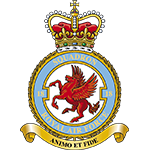RAF No. 229 Squadron
Motto: Kita chari jauh (We seek far)
Formed at Felixstowe in August 1918, it amalgamated No's 327 and 328 Flights, equipped with the Felixstowe F2A with the Camels of No 487 Flight . With the end of hostilities it avoided disbandment, being retained as a flying boat unit within Coastal Area, when it was formed. The squadron remained at Felixstowe until May 1922 when it moved to Calshot, however, on 1 April 1923 the unit was downgraded in status to No 480 Flight.
A new 230 Squadron formed at Pembroke Dock on 1 December 1934, still in the General Reconnaissance role equipped with Singapore III flying boats from the following April. From October 1935 until August 1936, the squadron operated from Egypt during the Abyssinian crisis. However, within two months of arriving back at Pembroke Dock, the squadron was on the move yet again, this time to Singapore. By January 1937 the squadron was established at Seletar and in June 1938, it received its first Sunderlands. From September 1939 it carried out patrols over the Indian Ocean and operated a detachment from Ceylon. This detachment got progressively bigger until the entire air complement was based on the island and in February 1940, those personnel remaining in Singapore where transferred to No 205 and 230 re-located officially to Ceylon.
Just prior to the entry of Italy into the war saw the squadron transferred again, this time to the Mediterranean operating from Egypt on anti-submarine patrols and reconnaissance operations for the Mediterranean Fleet until January 1943. At this time it moved further south to Dar-es-Salaam in East Africa, from where it once again operated over the Indian Ocean. During this period the squadron operated detachments in Madagascar, and back in the Mediterranean.
February 1944 saw the squadron retuning to Ceylon and a year later operated a detachment form Calcutta, which flew casualties and freight from their to Burma. April 1945 witnessed the squadron move to Burma for offensive operations against coastal shipping and in December the squadron once again returned to Singapore. However, in April 1946 230 was transferred back to the Calshot, where it remained until February 1949 when it arrived back at Pembroke Dock. The squadron took part in the Berlin Airlift prior to the move to Pembroke Dock, where it operated into Lake Havel. During the period 15 February 1949 and 30 April 1952 230 was linked with No 240 Squadron and later disbanded at Pembroke on 28 February 1957.
With the demise of the flying boat in RAF service, No 230's next incarnation was in the light transport role, when it reformed on 1 September 1958. It was reformed by the re-numbering of No 215 Squadron, which was equipped with Scottish Aviation Pioneer aircraft and was based at Dishforth. Operating alongside Army units, it received some Twin Pioneers in 1960. One flight was detached to the Cameroons in September 1961, returning a year later. In June 1961, the squadron began to receive Whirlwind HAR Mk 10 helicopters and by the end of the year was fully equipped and the last of the fixed wing aircraft had left.
The squadron moved to Germany in January 1963 remaining there until January 1965, however, two months later the squadron was sent to Borneo remaining there for a further two years until finally retuning to the UK in January 1967. Operating from Odiham until November 1969 when it moved to Wittering, a detachment began training on the Puma in October 1971 and on 3 December 1971 the squadron disbanded. However, on 1 January 1972, the training element at Odiham was officially allocated the number-plate 230. In October 1980 the squadron moved to Gutersloh in West Germany, where it operated until 30 April 1992, when its aircraft were handed over to No 18 Squadron and 230 disbanded. However, on 4 May 1992 and new 230 Squadron was re-formed at Aldergrove in Northern Ireland. Still equipped with the Puma, the squadron continues to operate in the province.
Battle Honours*
Home Waters, 1918: Mediterranean, 1940-1943: Egypt & Libya, 1940-1943: Greece, l940-1941: Malta, 1940-1942: Eastern Waters, 1943-1945: North Burma, 1944: Burma, 1945: Gulf, 1991:
Standards
originally awarded on 16 Oct 1956 but presented:- 1st - 26 October 1962 HRH The Duke of Gloucester 2nd - 27 October 1992 HRH The Duke of Gloucester.
FV Allocated Apr 1939 - Sep 1939 NM Sep 1939 - Jan 1943 DX 1942 - Dec 1942 4X Apr 1946 - Apr 1951 B Apr 1951 - 1956 230 1956 - Feb 1957 D Carried on Pumas (Odiham) F Carried on Pumas (Aldergrove)

 Editor for Asisbiz: Matthew Laird Acred
Editor for Asisbiz: Matthew Laird Acred
If you love our website please subscribe to our YouTube video channel
Please donate so we can make this site even better !!

